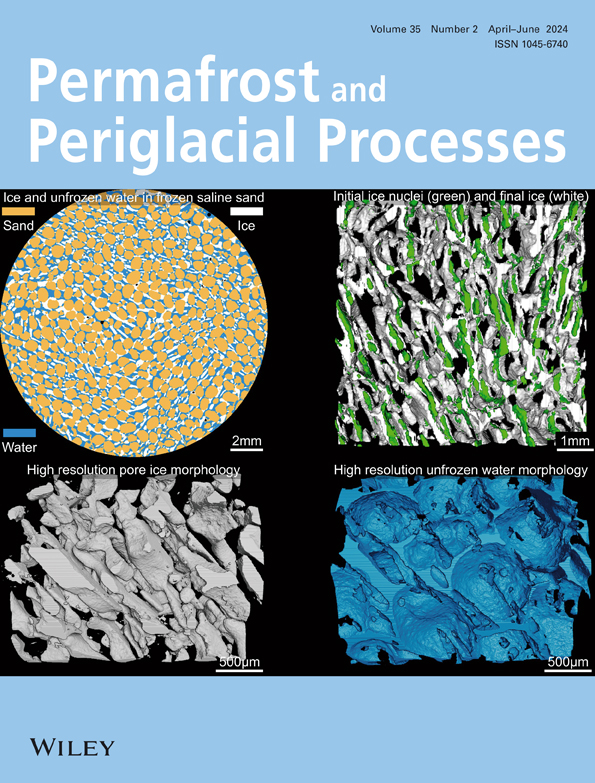First evidence of rock wall permafrost in the Pyrenees (Vignemale peak, 3,298 m a.s.l., 42°46′16″N/0°08′33″W)
IF 3.3
3区 地球科学
Q2 GEOGRAPHY, PHYSICAL
引用次数: 6
Abstract
Permafrost is a relevant component of the Pyrenean high mountains, triggering a wide range of geomorphological cryogenic processes. Although in the past decades there has been an increase in frozen ground studies in the Pyrenees, there are no specific studies about rock wall permafrost, its presence, distribution, thermal regime, or historical evolution. This work combines measured rock surface temperatures (RSTs, from August 2013 to April 2016) along an elevation profile (four sites) on the north facing the rock wall of the Vignemale peak (3,298 m a.s.l., 42°46′16″N/0°08′33″W) and temperature modeling (CryoGRID2) to determine the presence of permafrost and to analyze its evolution since the mid‐20th century. Simulations are run with various RST forcings and bedrock properties to account for forcing data uncertainty and varying degrees of rock fracturing. Results reveal that warm permafrost may have existed down to 2,600 m a.s.l. until the early 1980s and that warm permafrost is currently found at ~2,800 m a.s.l. and up to 3,000 m a.s.l. Cold (<−2°C) permafrost may exist above 3,100–3,200 m a.s.l. Systematic investigations on rock wall permafrost must be conducted to refine those results in the Pyrenees. The elevation shift in warm permafrost suggests an imminent disappearance of permafrost in the Vignemale peak.比利牛斯山脉岩壁永久冻土的第一个证据(Vignemale峰,3298 m a.s.l.,42°46′16〃N/0°08′33〃W)
永久冻土是比利牛斯山脉的相关组成部分,引发了广泛的地貌低温过程。尽管在过去的几十年里,比利牛斯山脉的冻土研究有所增加,但没有关于岩壁永久冻土、其存在、分布、热状况或历史演变的具体研究。这项工作结合了沿Vignemale峰(3298)北侧岩壁的高程剖面(四个地点)测量的岩石表面温度(RST,2013年8月至2016年4月) m a.s.l.,42°46′16〃N/0°08′33〃W)和温度建模(CryoGRID2),以确定永久冻土的存在并分析其自20世纪中期以来的演变。利用各种RST强迫和基岩特性进行模拟,以考虑强迫数据的不确定性和不同程度的岩石破裂。结果表明,温暖的永久冻土可能存在于2600年以前 m a.s.l.,直到20世纪80年代初,目前发现的温暖永久冻土约为2800 m a.s.l.和高达3000 m a.s.l.冷(<−2°C)永久冻土可能存在于3100–3200以上 m a.s.l.必须对比利牛斯山脉的岩壁永久冻土进行系统的调查,以完善这些结果。温暖的永久冻土的海拔变化表明Vignemale峰的永久冻土即将消失。
本文章由计算机程序翻译,如有差异,请以英文原文为准。
求助全文
约1分钟内获得全文
求助全文
来源期刊
CiteScore
9.70
自引率
8.00%
发文量
43
审稿时长
>12 weeks
期刊介绍:
Permafrost and Periglacial Processes is an international journal dedicated to the rapid publication of scientific and technical papers concerned with earth surface cryogenic processes, landforms and sediments present in a variety of (Sub) Arctic, Antarctic and High Mountain environments. It provides an efficient vehicle of communication amongst those with an interest in the cold, non-glacial geosciences. The focus is on (1) original research based on geomorphological, hydrological, sedimentological, geotechnical and engineering aspects of these areas and (2) original research carried out upon relict features where the objective has been to reconstruct the nature of the processes and/or palaeoenvironments which gave rise to these features, as opposed to purely stratigraphical considerations. The journal also publishes short communications, reviews, discussions and book reviews. The high scientific standard, interdisciplinary character and worldwide representation of PPP are maintained by regional editorial support and a rigorous refereeing system.

 求助内容:
求助内容: 应助结果提醒方式:
应助结果提醒方式:


